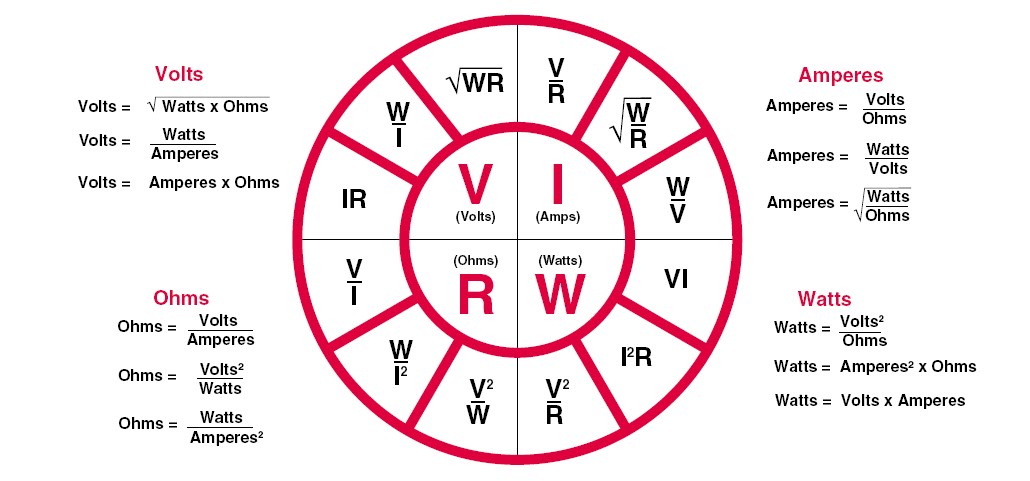MiniE 1: Ohm's Law // Let's learn: Basic Electronic
Law of life for electronics and electricians, if you want to understand and enter into matter, you must first know the basics, and if we ignore all the tedious formulas of derivation and integration our first task would be to understand Ohm's law. (Or at least it's how I decided it. If in doubt, ask;)).
Where:
V = Voltage, which is measured in volts.
R = Resistance, which is measured in ohms.
I = Intensity, which is measured in Amperes.
W = Power, which is measured in Watts.
This image is designed for easy understanding of the formulas. I will give a simple example so that you can understand or remember. Surely when you were children, in my country is a habit, they sent you a project to make a circuit with light bulbs, a switch and batteries. A bulb is a resistance (filament), of special shape and material, very thin that when crossing a current through it, it is heated to the point of generating luminescence.
The circuit is something like this:

This circuit is similar to the one we all have in our homes to light a light bulb, in contrast to: instead of using a battery with a constant voltage, through the bulb it passes 120 Vrms (Vrms: is the equivalent of an alternating voltage to a continuous voltage, I will explain it another time) in a sine wave at a frequency of 60Hz (this may vary depending on where you live).
Suppose that the light bulb we have at home consumes a potency of: 12W, a value set by the manufacturer after being subjected to the necessary tests, and the voltage it has, is exactly 120Vrms. We have voltage and potency, then, in the resistance, it should will pass an intensity of:
I = W / V = 12 [W] / 120 [V] = 0.1 [A]
And the resistance of the wire that is in the light bulb is of:
R = V / I = 120 [V] /0.1 [A] = 1200 [Ohms]
As additional information, when a light bulb decreases its light intensity is due to the decreased voltage, example, suppose that the voltage decreased to 100Vrms.
W = V ^ 2 / R = 10000 [V ^ 2] / 1200 [Ohms] = 8.33 [W]
The potency generated (or consumated) decreased, so it will illuminate less. On the other hand suppose that there is a peak of voltage (a sudden increase of voltage, they usually happen), and increases to 140 Vrms:
W = 19600 [V ^ 2] / 1200 [Ohms] = 16.33 [W]
Too much potency for the light bulb and to prevent heat from bursting the glass, fulfilling the same function as a fuse (protection), the wire breaks to prevent fires or damage to third parties.
I hope you have liked them, comment, make your requests, share, etc., greetings;).

This is a great explanation of a complex topic. The example of the light bulb made sense to me! I'm looking forward to more posts. Followed!
Thanks :D, I try to be as simple as possible. Of course, I have many ideas for blog material, wait for the second MiniE!!
I always was taught that 'I' = Current (not intensity). RMS = Root Means Squared, this is the same as taking the absolute value and it is about the AC voltage multiplied by .707, but you are correct that it is approximately the DC equivalent of the AC. Informative post. Thank you.
Yes, it is commonly known as "current", but the physical phenomenon is "Intensity", that is why the "I".
As for what you tell me about: RMS, you're right. This took importance because: At that time, there was first the continuous voltage and then the alternating voltage. Then to see the equivalence between the two, they were compared.
They looked for the exact value of a certain "current" (as you know) produced the same calorific effects as an alternating current over a given resistance. From there they simplified and came to postulate the mathematical equation. However, the 0.707 is due to the fact that the voltage coming from the outlets has no DC component, ie, the sine wave perfectly oscillates between "Vp, 0, -Vp". Of this last I do not remember much, perhaps I am mistaken, but I am almost sure that it is so.
Thanks for reply, I hope to see you in my next posts. The idea is also to exchange knowledge.
Thanks for clarifying. You can measure AC using peak-to-peak, peak, or RMS. What you described is peak-to-peak. That is where you measure the most positive and the most negative points, add the together (ignoring the negative sign). Peak is just one side, either the positive or negative. You already know the RMS. To convert, you divide peak-to-peak by 2 and multiply by .707 = RMS. I'm sure you can calculate RMS from peak. And this is based on if you are generating a pure sine wave. The calculation is different if you have a square or a saw tooth wave. You are correct that for certain things you need to evaluate the circuit in a DC rather then an AC value. But if you deal in radio transmission, you need to understand how DC is used to set a 'Q' point so you can correctly bias a transistor. The AC is the signal you are trying to amplify. It sounds somewhat convoluted but if you understand the basics (e.g. ohm's law, kirchhoff's and thevenin's theorem) it becomes easier.
Yes, I enjoy bantering with you and hope to do more in the future. Have a good evening.